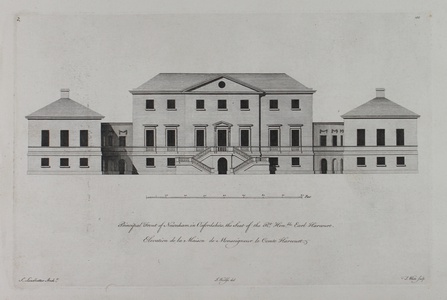| Method | Copper engraving |
| Artist | Thomas White after John Woolfe |
| Published | S. Leadbetter Archt. J. Woolfe del. T. White sculp. [London, 1765-1771] |
| Dimensions | Image 155 x 355 mm, Plates 245 x 375 mm, Sheets 365 x 565 mm |
| Notes |
Titled in English and French. A finely engraved architectural view of the principal front of Nuneham House, Oxfordshire, from the Woolfe and Gandon volumes of Vitruvius Britannicus, or, The British Architect. Nuneham was built for Simon Harcourt, 1st Earl Harcourt in the mid 1700s, to a Palladian design by Stiff Leadbetter. The house occupied the site of an earlier structure, and the original medieval village of Nuneham Courtney was demolished in order to surround the house with a grand landscape garden laid out by Capability Brown. The village was completely rebuilt on its current site, and even the Oxford to London road was moved for the project. The destruction of the village and its farms to make way for a pleasure garden are usually identified as the inspiration for Oliver Goldsmith's poem The Deserted Village. Vitruvius Britannicus or, the British Architect. Containing the Plans, Elevations, and Sections of the most Regular Buildings both Publick & Private in Great Britain was the first architectural work to emerge from England since John Shute's The First and Chief Groundes of Architecture, which was first printed in 1563. Often regarded as a catalogue of designs, Vitruvius Britannicus contained a number of plans, elevations, and sections of buildings in Great Britain by the most prominent architects of the day, including Inigo Jones and Sir Christopher Wren. The text as well as a great many of the designs were the work of the Scottish architect Colen Campbell, with the first three volumes being published between 1715 and 1725. The success of Vitruvius Britannicus was instrumental in popularising neo-Palladian Architecture in Great Britain and America during the eighteenth century, and was one of the driving forces behind the development of Georgian architecture. The book inspired two significant imitators, both of whom borrowed the title for their own publications. The first, in 1739, was published by Badeslade and Rocque, but featured mostly topographical views. Between 1765 and 1771, the architects Woolfe and Gandon issued their own two volume set as Vitruvius Britannicus Volumes IV and V. In style, their publication was a much closer fit to the Campbell originals, and featured some of the finest examples of architecture to have appeared in the 40 years between the two books. Thomas White (c.1740-1775) was a British engraver and draughtsman, who worked mostly on architectural plates. John Woolfe was an Irish draughtsman active in the latter half of the eighteenth-century. From the 1750s onwards, Woolfe was employed in the Office of Works. He was the joint author with James Gandon of volumes 4 and 5 of Vitruvius Britannicus. His son, of the same name, worked for the Office of Works between 1787 and 1806. Colen Campbell (1676-1729) was a Scottish architect and architectural writer, credited as a founder of the Georgian style. He is best known as the author of Vitruvius Britannicus. Condition: Minor time toning and chipping to edges of sheet. |
| Framing | unmounted |
| Price | £125.00 |
| Stock ID | 50878 |

